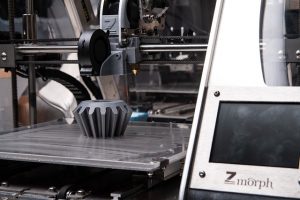
Many people assume that the terms “3D printing” and “additive manufacturing” refer to the same manufacturing process of building objects by depositing layers of material. The two terms, in fact, have become synonymous with this manufacturing process. So, what’s the difference between 3D printing and additive manufacturing exactly?
What Is 3D Printing?
3D printing is a manufacturing process in which an object is created layer by layer using a machine, known as a 3D printer, and CAD software. This is in stark contrast to conventional manufacturing processes where material is removed from a workpiece. With milling, for instance, objects are created by removing material from a workpiece. With 3D printing, objects are created by depositing layers of material. The CAD software instructs the 3D printer on how much material to deposit and where to deposit it.
Most 3D printers use polymer for the printing material. It’s a versatile and readily available material that works well for 3D printing applications. With that said, some 3D printers support metals, alloys and even ceramics.
What Is Additive Manufacturing?
The term “additive manufacturing” refers to the creation of objects by “adding” material. Therefore, 3D printing is a form of additive manufacturing. When an object is created by adding material — as opposed to removing material — it’s considered additive manufacturing. Like 3D printing, additive manufacturing typically requires the use of a machine as well as CAD software. The machine follows the instructions from the CAD software to build the desired object by adding material.
Between 3D Printing and Additive Manufacturing
3D printing is a form of additive manufacturing. However, additive manufacturing is a broader term that encompasses a wider range of processes than its 3D printing counterpart. Electron-beam manufacturing and selective laser melting, for example, are considered additive manufacturing processes. Neither of them build layers of material, but they still involve the creation of objects by adding material. Therefore, electron-beam manufacturing and selective laser melting are considered forms of additive manufacturing.
It’s also worth mentioning that the term “additive manufacturing” is most commonly associated with industrial and commercial applications, whereas the term “3D printing” is most commonly associated with consumer and recreational applications.
In Conclusion
The main difference between 3D printing and additive manufacturing is that 3D printing specifically involves the creation of objects by building layers of material. In comparison, additive manufacturing involves the creation of objects by adding material, which may or may not come in layers.
Learn more about Monroe’s Additive Printing Service or get your parts printed now!
No tags for this post.
